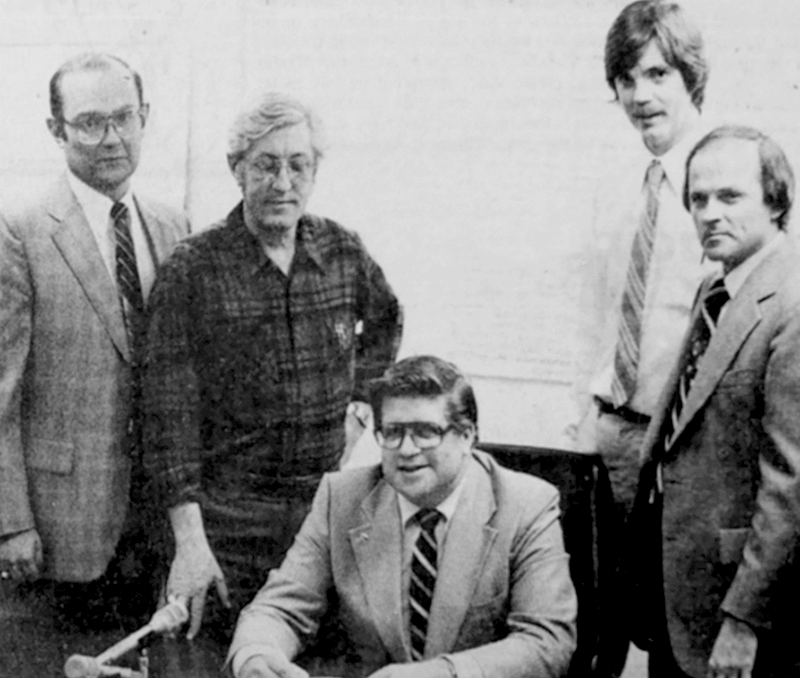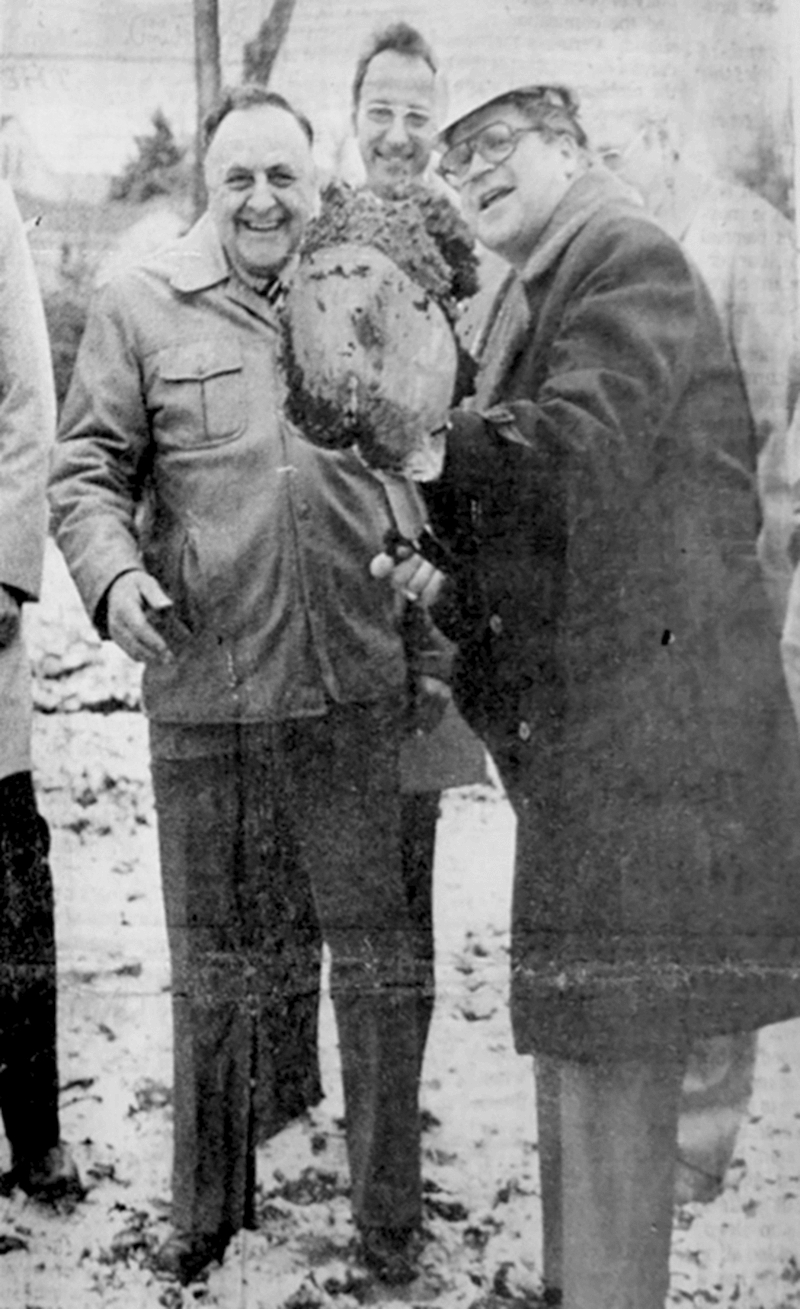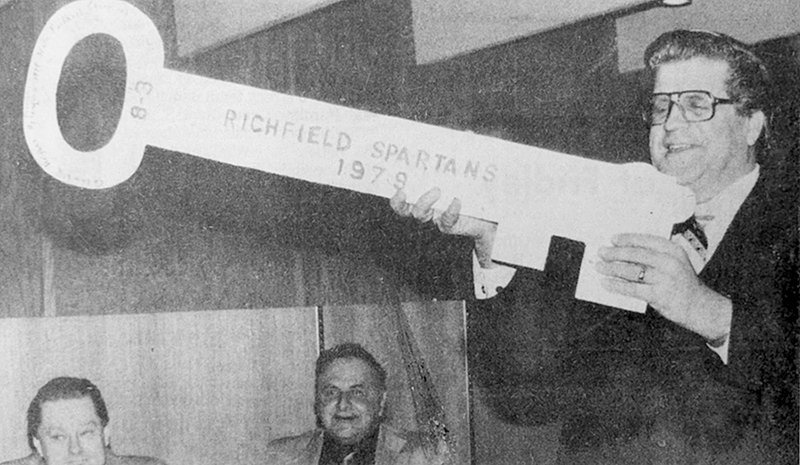In recent years, one Columbia Heights city council member in particular would pull items off the council’s Consent Agenda for more information and discussion. But, the days of adjourning at 3 or 4 a.m. are long, long past.
Bruce Nawrocki, ever the questioner and champion of not spending too much, succumbed to the rap of life’s final gavel Friday evening, April 6.
His 22 consecutive years as Columbia Heights mayor and a previous four-year council stint encompassed years of rapid growth and development including street and alley paving, rebuilding water and sanitary sewers, establishing a stormwater system, the first city hall and police station, liquor stores, parks and recreation buildings and the city’s first dedicated library. In Nawrocki’s subsequent 20 years on the council (1990-1994 and 2000-2016), over his initial objections, the city replaced its library.
City and government in the 1960s to 1980s
Council meetings started at 8 p.m. Malcolm Watson was public works manager and then city manager for two decades. He described “the Monday night fights.”
Nawrocki was “strongly political. He thought it was important to keep the meetings going, to make sure everyone was heard, even if it took until 1:30, 2:00 or 4:00 in the morning. We had our differences and thrashed everything out openly. Everyone was heard,” Watson said.
Watson is just the first of city managers Nawrocki sparred with. Watson quit the post on his 20th anniversary of service in August 1977. He said in a newspaper interview then that he’d learned patience on the job. Watson stayed in the city, starting an appraisal business with a partner. Two years later he ran for mayor but narrowly lost to Nawrocki.
A November 22, 1979 Minneapolis Star article examined the job of suburban city managers. The article ended: “Enter again the vision of city manager as knight-errant, moving on to slay new dragons and appease new royalty.” Asked for a reaction to that image, Columbia Heights [new City Manager Bob] Bocwinski laughed loudly and said, “Yeah, I suppose you could characterize us that way. Either that or by the desk drawer with a bottle of aspirin and a bottle of Tums.”
Current City Manager Walt Fehst, who’s been on the job since 1996 and grew up on Chicago’s South Side, finds Bocwinski’s quote amusing and true, but said, “with Bruce [as council member] it was more form than substance. He could be a bully but I didn’t put up with it. I gave it back; I would get under his skin purposely. He’d make the staff the whipping boy and I defended my staff. It unnerved some. His heart was in the right place … I grew to appreciate that Bruce wanted to be in a position to help somebody.” And it’s a way to catch mistakes that sometimes get made.
It was not until February 1984 that the council moved the start time to 7:30 p.m. They also then started to consider a consent agenda process, which Nawrocki agreed would shorten the meetings.
That system is in use today – items considered procedural and non-controversial are put on the consent agenda but may be removed at a council member’s request, for discussion at the same meeting after the consent agenda passes. The council receives supporting documents to review before the meeting. And the meetings start at 7 p.m., on second and fourth Mondays.
In the 1980s, an era where local housing and redevelopment authorities paid their staffs through fees collected for facilitating projects, developers built housing projects of various sorts. And Mayor Nawrocki promoted government intervention to revitalize a downtown business district that had declined after the 1940s, he said, due to absentee ownership. Government intervened after efforts to work through the existing businesses didn’t work.
When Invest Cast looked at moving in from Blaine where their facilities burned, to 716 39th Ave. NE in 1985, Nawrocki said he’d seen the Blaine facility and was not impressed with its cleanliness or organization. “You ask the tough questions right up front.” He said he was deliberately tough because that was better than allowing the company to move in, and then discovering unforeseen problems. Then-Council Member Rita Petkoff said Nawrocki was showing hostility to a new business.
When Dale Hadtrath trounced Nawrocki 2,403 to 1,484 in the 1987 election, Hadtrath attributed his mayoral win in part to voters feeling the city had a bad atmosphere for businesses. That, and the council had voted themselves a pay raise – the mayor would make $12,000 (up from $10,200) and “it was time for a change.”
Nawrocki told his supporters, “When you’ve been in office as long as I have, you have to expect sooner or later something like this is going to happen. Anytime you vote to assess a property or charge a higher fee, you’re bound to make someone angry, over the years I’ve voted on thousands of issues.”
In some mayoral races, Nawrocki ran unopposed; others were won by narrow margins. Some describe him as a ward heeler, earning lawn sign locations and votes by helping individuals.
Nawrocki stayed active after the loss, participating in the controversy over renovating Huset Park in 1988. And in the 1989 election, he got back on the council with just a few votes less than newcomer Sean Clerkin. Then, through a succession of mayors – Ed “The Barber” Carlson, Don Murzyn, Joe Sturdevant, Gary Peterson, Julienne Wyckoff, and Gary Peterson again, Nawrocki remained the budget hawk and brought his advocacy for the “little guy” to the council.
Sun newspaper articles covered discussion of lifting the ban on parking on Heights streets at night in August 1980. There was debate over allowing Sunday liquor sales at restaurants. Throughout the early 1980s there was a long and winding battle to put a recreational center at the old Columbia School. (Eventually NEI College of Technology bought the building, though not without some verbal roughing up.)
Nawrocki helped avert a strike by city clerks and technicians by mediating through the night, it was reported on April 7, 1982. Daily newspapers had gone to press with word that the strike was on. Nawrocki reportedly suggested some compromise language.
Not long after, the city laid off five staff members, including some department heads, to cut $368,000 because of reduced state aid.
Political scene
Nawrocki participated in the political scene beyond city boundaries. He served on the Metropolitan Transit Commission from 1971, according to an announcement of his reappointment in 1983. He served as president of the Minnesota League of Cities and was the city’s delegate to that body even in recent years. There’s a photo of Nawrocki and George Marks of the St. Anthony City Council, with Congressman Gerry Sikorski in April 1983: Local officials in Washington, D.C., for the National League of Cities conference.
For several years Nawrocki lobbied for three large counties, and later collected a pension based on combining that job with his time in office.
In 1995, when longtime State Representative Wayne Simoneau resigned to become acting commissioner of the State Department of Employee relations, Skip Carlson won the post, beating candidate Nawrocki and becoming “the first Republican in generations” to hold the House seat.
In the early 1980s, Nawrocki suggested looking at a merger between Columbia Heights and Fridley to save expenses; he brought it up in two successive Mayor’s State of the City addresses. It’s come up occasionally since, Fehst said.
In 1955, just a few years before Nawrocki got on the council, Columbia Heights had annexed parts of Fridley Township. In 1956, Heights turned down the request by two trailer parks to annex them – and thus Hilltop incorporated on its own. According to Wikipedia, rivalries over liquor licenses, water and other city services ensued until in 1968, when Hilltop mayor Vivian Caesar and Heights mayor as of 1965, Nawrocki, met alongside their respective city councils to discuss mutual issues.
But “Fridlumbia,” as the Sun Newspaper called it, did not go anywhere.
Ceremonies and causes
While there were many groundbreakings and ribbon cuttings to celebrate throughout his career, Nawrocki also lent his ceremonial pen to sign dozens of proclamations and such, posing for the newspapers’ cameras. He helped tie yellow ribbons for hostages in Iran in October 1980. In April 1983, he signed a proclamation of Private Property Week with real estate agent Ralph “Mickey” Rooney looking on, celebrating “one of this country’s most basic rights – to own private property.”
A group of politicians and other notables, including Nawrocki and wife Gerry, Rita Petkoff and Malcolm Watson modeled clothing in the 4th Annual Style Show sponsored by the Columbia Heights Jaycee Women March 20, 1982. Proceeds benefitted Alexandra House, an Anoka County shelter for battered women.
The Nawrockis were present at then- County Commissioner Al Kordiak’s fiftieth birthday party in 1978, and Kordiak helped put on an “appreciation night” for Bruce Nawrocki celebrating his fiftieth birthday and twentieth year of service to the city in August 1981. Other celebration committee members: Mickey Rooney, Ron Laliberte, Dick Petkoff, Mike Farrell, Jo-Anne Student, Bob Hinrichs, Dick Dustin, Jim Stafford, Howard Seim, Sebe Heintz, Dave Torkildson, Rosemary Byrnes and Marcia Bennett.
Personal insights
Gerry Nawrocki said her husband’s drive to serve the city stemmed from squalid conditions he observed during military service in Korea and Northern Japan. “He knew how fast things could go downhill and he never wanted his town and his people” to decline, she said. Bruce once wrote a letter describing an elderly woman clubbing a little boy with her cane over a discarded orange outside the army camp, telling Gerry, “I know I will never see anything so horrible.”
“He was active in so many things. With the jobs he did hold, he was able to be flexible. He made sure he was at everything the kids did, and to be home before they went to bed. He may have gone back out later, but he was there.” Gerry said he’d enjoyed visits from grandchildren and great-grandchildren, too.
Nawrocki sold and built industrial furnaces and incinerators, he had an insulation business for a while, managed a small mall, and then there was the county lobbying job. He had worked for a floral delivery service right out of the military.
“Bruce wanted to be noted for always answering every call. He would call back until he got hold of someone. It was a rule in our house—no, a LAW—that anyone who called would get a call back, so we had to be good about taking messages.” Nawrocki had a separate phone line for city business. “We were really happy when phone answering machines came about,” Gerry said.
Gerry’s favorite story is the woman who called after a several-day power outage telling the mayor that her son had suggested she call, that Nawrocki would take care of her. He happened to be on the other line with NSP, but when he was done, he placated her the best he could. She called back almost immediately to say, “My lights went back on the minute I called you! My son was right.”
The newspaper obituary penned by former City Council Secretary (1980-2000) Jo-Anne Student reads, “Bruce Nawrocki and Columbia Heights are interchangeable words. When you think of one, you think of the other. Bruce leaves a legacy of public service that will long serve as a model of commitment, leadership, and selflessness. He viewed his position as Mayor as an opportunity, not an obligation.”
She told the Northeaster, “maybe his style was challenging, but he got the job done. I trusted his judgment. He had proof he knew what he was doing. He was careful of the purse strings. He was frugal, and the taxes were fair.”
About the late meetings, “it was interesting to see how people would decompose. I never minded it,” Student said, remembering nights when snowstorms would develop while the public met into the wee hours (and there was no cable broadcast in those days, and smoking was allowed).
Student commented that in recent years, Nawrocki “didn’t mind the changes” in the city. “He thought they were good. “
Writing the obituary brought home the finality of burying a friend. “He will be missed.” Funeral services were held Friday, April 13.
Former Mayor Gary Peterson joked about their “one-on-ones” — verbal sparring that may have upped the cable TV viewership of the council meetings.
Pastor Dan Thompson officiated, at Bruce’s request, talking about time as a healer, and a changing of perspectives.
Bruce Gordon Nawrocki leaves behind his wife and high school sweetheart Geraldine, “Gerry;” his son, Joel; daughter, Beth-Anne; granddaughters Alicia, Amy Ann and Ashley; grandson, Andrew; and great-grandchildren, Athena, Martin, Simon and Vivian. An almost life-long resident of the Heights (he moved as a child from Northeast Minneapolis), he graduated Columbia Heights High School in the Class of 1949, spent four years at the University of Minnesota, and had special training in U.S. Army electronics.
He was a member of Columbia Heights Lions Club, Columbia Heights Sister Cities Committee, and Columbia Heights VFW Post 230 in addition to various boards and commissions assigned to council members. Until his health started to fail, Nawrocki also participated in the relatively new community group, Heights NEXT.
His wife said about a week before he went into a nursing facility, against her wishes, Bruce snuck the car out, went to the bank, post office, and “drove around the city to see if they were plowing right.”
Below: Mayor Bruce Nawrocki signed the insurance bonds for a $9 million condo project in January 1981. City Manager Bob Bocwinski and Council Member Sebe Heintz are at left, HRA Director Roger Jensen and bond attorney Jim Holmes at right. In March 1981, Nawrocki threw a first shovel full of dirt at the project’s groundbreaking with Kenny Hentges and Al Kordiak. Bruce Nawrocki held high a key to the city of Richfield after winning a wager with Richfield’s mayor when the Hylanders beat the Spartans in state class AA football championships in November of 1979. Editor’s Note: Sources, if not directly attributed, include clipping files of the Columbia Heights Sun and its successors, and the
Northeaster.


